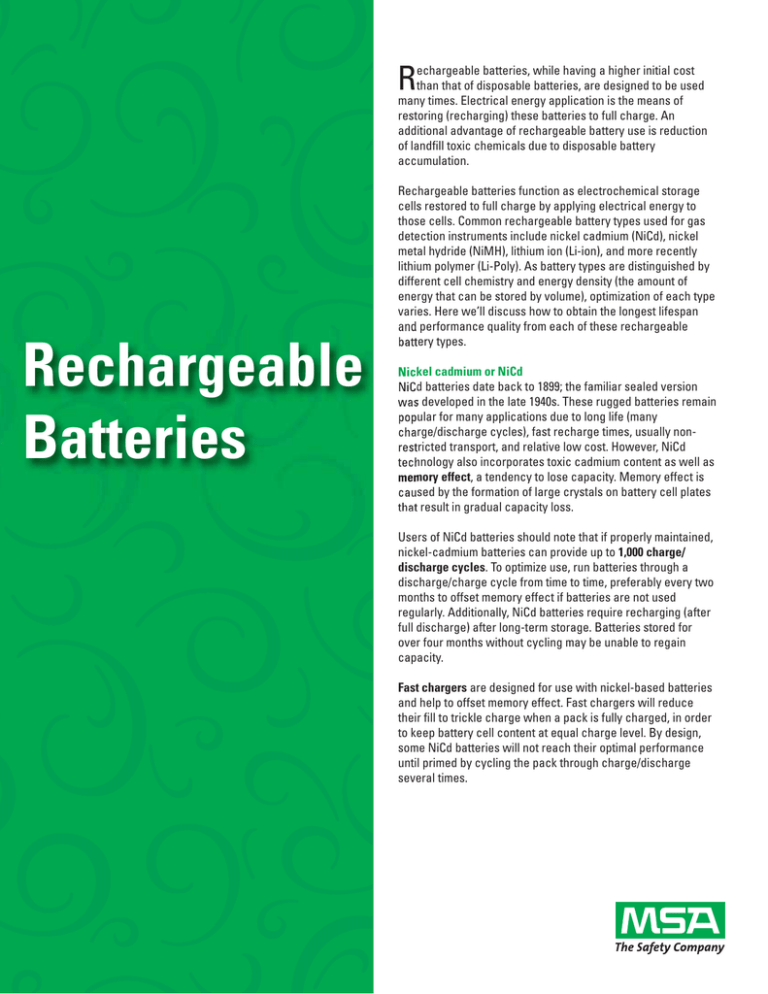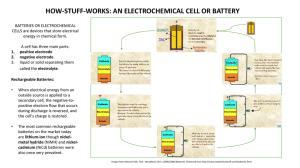Rechargeable Batteries
advertisement

echargeable batteries, while having a higher initial cost than that of disposable batteries, are designed to be used many times. Electrical energy application is the means of restoring (recharging) these batteries to full charge. An additional advantage of rechargeable battery use is reduction of landfill toxic chemicals due to disposable battery accumulation. R Rechargeable Batteries Rechargeable batteries function as electrochemical storage cells restored to full charge by applying electrical energy to those cells. Common rechargeable battery types used for gas detection instruments include nickel cadmium (NiCd), nickel metal hydride (NiMH), lithium ion (Li-ion), and more recently lithium polymer (Li-Poly). As battery types are distinguished by different cell chemistry and energy density (the amount of energy that can be stored by volume), optimization of each type varies. Here we’ll discuss how to obtain the longest lifespan and performance quality from each of these rechargeable battery types. Nickel cadmium or NiCd NiCd batteries date back to 1899; the familiar sealed version was developed in the late 1940s. These rugged batteries remain popular for many applications due to long life (many charge/discharge cycles), fast recharge times, usually nonrestricted transport, and relative low cost. However, NiCd technology also incorporates toxic cadmium content as well as memory effect, a tendency to lose capacity. Memory effect is caused by the formation of large crystals on battery cell plates that result in gradual capacity loss. Users of NiCd batteries should note that if properly maintained, nickel-cadmium batteries can provide up to 1,000 charge/ discharge cycles. To optimize use, run batteries through a discharge/charge cycle from time to time, preferably every two months to offset memory effect if batteries are not used regularly. Additionally, NiCd batteries require recharging (after full discharge) after long-term storage. Batteries stored for over four months without cycling may be unable to regain capacity. Fast chargers are designed for use with nickel-based batteries and help to offset memory effect. Fast chargers will reduce their fill to trickle charge when a pack is fully charged, in order to keep battery cell content at equal charge level. By design, some NiCd batteries will not reach their optimal performance until primed by cycling the pack through charge/discharge several times. Nickel metal hydride or NiMH Stable metal hydride alloys came about in the 1980s after years of development. Rechargeable nickel metal hydride or NiMH batteries generally have higher energy densities (30-40% compared with that of NiCad batteries) and use relatively environmentally-friendly metals. While NiMH batteries are also less prone to memory effects than are NiCad packs, they also display higher self-discharge percentages. To obtain optimum battery service life from your batteries, storage is advised when batteries are partially charged (40%) at cool temperatures, as higher temperature storage can reduce battery service life. When batteries are not in use their aging effects slow down. Upon receipt of a new battery, cycle it by fully recharging, discharging, and then recharging once more to reach its full capacity. To optimize run times, regular NiMH battery cycling should be performed at least every three months, helping to prevent internal crystallization. Cold batteries should be allowed to stabilize for half an hour at room temperature before recharging. NiMH batteries should be used with fast chargers, as slow chargers are unlikely to perform effectively due to lack of full saturation tendencies or possible overcharge. When properly maintained, NiMH batteries can last through 500-1000 cycles. Lithium ion or Li-ion This low maintenance battery type became available in the 1970s and popular in the early 1990s due to their practicality when used with consumer electronics. They are lightweight and have no memory effects; cycling and priming after initial charge-up are unnecessary. Their electrolyte content allows for conformation when manufactured to many applications. These batteries lose charge very slowly; however, permanent capacity deterioration does occur with lithium ion cells whether or not batteries are in use. Partially charged batteries (40%) should be stored at cool temperatures, helping to prolong its service life. Typical lithium ion batteries can last through 300-500 cycles under normal use before capacity drops under 80%. Lithium polymer Lithium polymer batteries are noticeably low-profile and posses a flexible form factor, making them ideal for use with consumer electronics. Gelled electrolytes combined with dry solid polymer electrolyte allow for such flexibility by eliminating the need for metal shells. Electrolyte leakage possibility is also reduced, although their energy density is slightly less than that of typical lithium-ion packs. Lithium polymer batteries are also more resistant to users’ tendencies to overcharge battery packs. A disadvantage of dry lithium-polymer is its poor conductivity due to the high internal resistance, limiting current spikes needed to power certain types of gas detection instruments. General guidelines for battery charge optimization: Avoid high temperatures during charging. Discontinue use of chargers that cook batteries. NiMH chargers can accommodate NiCad batteries but not the other way around, as NiCad-specific chargers will overcharge NiMH batteries. Nickel-based batteries prefer fast-charge, as lingering slow-charge can cause crystalline formation (memory). Nickel- and lithium-based batteries require different charge algorithms, as the two chemistries cannot normally be interchanged using the same charger. If not used immediately, remove batteries from chargers and apply topping-charge before use. Do not leave nickel-based batteries sitting in chargers for more than a few days, even if on trickle charge. Lithium ion batteries incur relatively high manufacturing costs, as much as 40% higher than that of NiCd and NiMH batteries. Transportation restrictions do exist for large shipments of lithium ion. Note: This Bulletin contains only a general description of the products shown. While uses and performance capabilities are described, under no circumstances shall the products be used by untrained or unqualified individuals and not until the product instructions including any warnings or cautions provided have been thoroughly read and understood. Only they contain the complete and detailed information concerning proper use and care of these products. ID 0816-76-MC / Oct 2008 © MSA 2008 Printed in U.S.A. Corporate Headquarters P.O. Box 426, Pittsburgh, PA 15230 USA Phone 412-967-3000 www.MSAnet.com MSA Mexico Phone (52) 55 2122 5770 Fax (52) 55 5359 4330 U.S. Customer Service Center Phone 1-800-MSA-2222 Fax 1-800-967-0398 MSA International Phone 412-967-3354 Fax 412-967-3451 MSA Canada Phone 1-800-672-2222 Fax 1-800-967-0398


